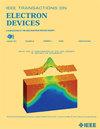基于栅极间层的栅极侧注入型场效应管程序效率的实验分析与数学建模
IF 3.2
2区 工程技术
Q2 ENGINEERING, ELECTRICAL & ELECTRONIC
引用次数: 0
摘要
本文通过实验分析了具有金属-栅极间层-铁电体-沟道间层-硅层结构的栅侧注入型MIFIS效应管的增量阶跃脉冲规划(ISPP)特性,重点讨论了栅极间层的作用。我们还提出了考虑铁电(FE)开关行为的数学模型。由于从栅极和极化开关动力学中注入电荷(${Q}_{\text {it}}}'$),与典型的通道侧注入型电荷陷阱闪光(CTF)器件相比,MIFIS fefet最近获得了更低的程序(PGM)电压和更宽的存储窗口(MWs),因此引起了人们的关注。然而,关于g.i对nand细胞至关重要的ISPP特性和耐力的影响的指南缺乏。在这里,我们实验研究了g.l l对MIFIS ffet ISPP斜率的影响,并通过数学建模,提出了一个g.l l设计来优化MIFIS ffet的性能。此外,我们还分析了g.l l类型对续航性能的影响,认为从g.l l注入的过多的${Q}_{\text {it}}$和极化钉钉一起导致了整体续航性能的下降。最后,我们证明了通过使用低$\kappa $ SiO2 G.IL (6 nm),可以实现6.5 V的MW和大于3的ISPP斜率。我们的MIFIS ffet即使在超过14 V的电压下也具有抗干扰性,这对于防止在各种干扰下${V}_{\text {th}}$移位至关重要。我们的研究和模型可以为门注入型ffet的研究提供有价值的指导,该技术正在积极探索作为下一代nand闪存技术。本文章由计算机程序翻译,如有差异,请以英文原文为准。
Experimental Analysis and Mathematical Modeling of Program Efficiency in Gate-Side Injection Type FeFETs Depending on the Gate Interlayer
We experimentally analyze the incremental step pulse programming (ISPP) characteristics of gate-side injection type MIFIS FeFETs, which feature a metal – gate interlayer (G.IL) – ferroelectrics – channel interlayer (Ch.IL) – Si stack, with a focus on the role of the G.IL. We also propose a mathematical model considering ferroelectric (FE) switching behavior. MIFIS FeFETs have recently garnered attention due to their ability to achieve lower program (PGM) voltages and wider memory windows (MWs) compared to typical channel-side injection type charge trap flash (CTF) devices, thanks to the injection of charges ( ${Q}_{\text {it}}'$ ) from the gate and polarization switching dynamics. However, guidelines on the influence of the G.IL on ISPP characteristics and endurance, critical for nand cell, are lacking. Here, we experimentally investigate the impact of the G.IL on the ISPP slope of MIFIS FeFETs and, through mathematical modeling, propose a G.IL design to optimize MIFIS FeFET performance. Furthermore, we analyze the degradation of endurance characteristics depending on the type of G.IL, suggesting that the excessive ${Q}_{\text {it}}$ injected from the Ch.IL, together with polarization pinning, contributes to overall endurance degradation. Lastly, we demonstrate that by utilizing a low- $\kappa $ SiO2 G.IL (6 nm), a MW of 6.5 V and an ISPP slope greater than 3 can be achieved. Our MIFIS FeFET also exhibits disturbance immunity even at voltages exceeding 14 V, which is critical in preventing ${V}_{\text {th}}$ shifts during various disturbances. Our research and model can provide valuable guidelines for the study of gate-injection type FeFET, which are actively being explored as next-generation nand Flash memory technologies.
求助全文
通过发布文献求助,成功后即可免费获取论文全文。
去求助
来源期刊

IEEE Transactions on Electron Devices
工程技术-工程:电子与电气
CiteScore
5.80
自引率
16.10%
发文量
937
审稿时长
3.8 months
期刊介绍:
IEEE Transactions on Electron Devices publishes original and significant contributions relating to the theory, modeling, design, performance and reliability of electron and ion integrated circuit devices and interconnects, involving insulators, metals, organic materials, micro-plasmas, semiconductors, quantum-effect structures, vacuum devices, and emerging materials with applications in bioelectronics, biomedical electronics, computation, communications, displays, microelectromechanics, imaging, micro-actuators, nanoelectronics, optoelectronics, photovoltaics, power ICs and micro-sensors. Tutorial and review papers on these subjects are also published and occasional special issues appear to present a collection of papers which treat particular areas in more depth and breadth.
 求助内容:
求助内容: 应助结果提醒方式:
应助结果提醒方式:


